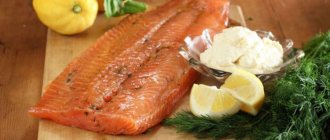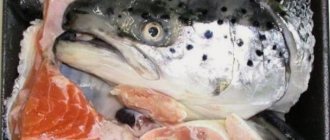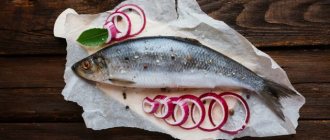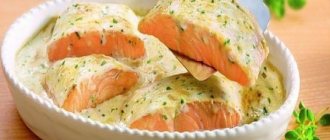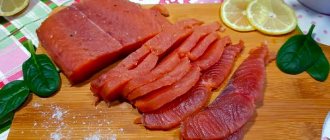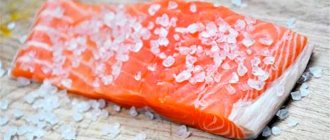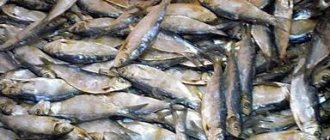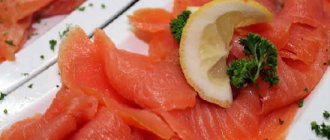How to salt trout at home
You can salt trout in different ways. However, they all involve the same technology. First you need to cut the fish. If fillet is required, remove the bones. The next step will be the production of brine or dry pickling mixture. The fish will need to be placed in a container and filled or covered with seasonings. The salting of trout will end by sending the container under pressure to the refrigerator so that the product is well salted and saturated with the aroma of spices.
How much to salt trout at home
Each person has different ideas about delicious salted fish. There are two methods for how long to salt trout:
- Lightly salted fish carcass will need to be salted in marinade or spices for a short time. This salting is considered a quick way to obtain a delicacy. It takes several hours to prepare a lightly salted dish. The taste of such fish is distinguished by its tenderness.
- Fans of a more savory product will enjoy well-salted fish. It is necessary to pickle fish in brine or spices for a period of 1 to several days. It has a sharper, saltier taste.
Lifestyle
It is believed that all fish of the salmon family (the list of representatives is very large) are predators by nature. Many people find small crayfish in their stomach while cutting. There are also other fish. In general, brown trout are not fixated on their diet; they are ready to eat everything that comes their way.
But there are other examples. There are two representatives of the breed in Lake Ohrid. The first, trout, reaches a weight of 10 kg and it feeds exclusively on meat products. The second specimen is a small silver fish. Its diet consists only of small crustaceans or plankton. Beginners and amateurs often mistake them for representatives of different families. And few people can tell by their appearance that they belong to the same breed.
Brown trout spend most of their lives in salt water. It swims to freshwater rivers to spawn. The fry grows there too. As an adult, it returns to the sea or salt water lake.
How to salt trout at home with salt and sugar
- Preparation time: 1-2 days.
- Number of servings: 8 persons.
- Calorie content of the dish: 198 kcal.
- Purpose: for dinner / holiday table.
Using the dry method with the addition of salt and sugar is one of the simplest options for salting salmon. You will need a minimum of components and effort. The product turns out very tasty and tender. Ready-made fish can be used for sandwiches, as a snack on a holiday table or family dinner, and used for making salads.
- granulated sugar – 1 tbsp. l.;
- trout (fillet) – 1000 g;
- bay leaf – 3 pcs.;
- sea salt – 3 tbsp. l.;
- lemon juice;
- spices for fish;
- black peppercorns – 5 pcs.
- Take a deep bowl. Place some sugar and salt on the bottom. Place a piece of fresh fish on top, skin side down, then add the sweet and salty mixture again.
- Pour a little lemon juice over the fillet, add a bay leaf and sprinkle with seasonings.
- Place the second part of the fish, skin side up, sprinkle with sugar and salt.
- Press down the product with a three-liter jar of water and place in a warm place for 120 minutes.
- Then remove the press and cover the dish with a lid. Place the fillet in the refrigerator.
- Dry salting of trout will last 1-2 days.
With broccoli
Broccoli goes well with brown trout. You can prepare a healthy dish by baking everything in the oven. Recipe with photo. For this you will need:
- 3 trout steaks with a total weight of 1 kg;
- 250 g broccoli;
- 1 onion;
- salt to taste;
- 20 ml olive oil;
Preparation:
- Wash the steaks and cut into 2 parts;
- Chop the onion and place it on the bottom of the baking dish;
- Place the fish on top, salt, grease with oil and place broccoli on top of the fish;
- Cover with foil and place in the oven for 20 minutes at 200 degrees;
- After the specified time, remove the foil and leave the fish to cook for another 10 minutes.
This amount of fish will yield 3 servings of the finished dish.
Cooking time: 15 minutes. Cooking time: 30 minutes.
BJU dishes - 219/61/20. Calorie content - 1500 kcal.
BJU for 100 gr. - 16/4/1.5. Calorie content - 109 kcal.
Salted trout at home
- Cooking time: 7 hours.
- Number of servings: 4 persons.
- Calorie content of the dish: 186 kcal.
- Purpose: dinner/celebratory table.
- Cuisine: Scandinavian, Russian.
- Difficulty of preparation: easy.
Low salt red fish will appeal to those who prefer to preserve the taste of the product as much as possible. The most tender fillet is suitable for holidays and for the family table at dinner. Lemon juice will help highlight the taste of the dish. It takes very little time to pickle such a delicacy. After waiting a few hours, you will receive a tasty and tender fish fillet.
- Wash fresh fish, remove skin and bones. Divide the fillet into small pieces with a knife and place them in a container where you will cook lightly salted fish.
- Cut the lemon into thin semicircles. Place the resulting slices on the fish. Salt the dish and sprinkle with pepper.
- Cover the resulting preparation with a lid and place it in the refrigerator overnight. In the morning, lightly salted trout at home with lemon will be ready.
Learn how to pickle trout caviar at home.
Brown trout meat
The salmon breed in question is in no way inferior to animal meat in terms of taste and culinary qualities. Moreover, when prepared correctly, it is even better. First of all, this lies in the fact that meat is easily digestible, even by small children.
Trout is not an oily fish, but very tender. This is due to the fact that there are layers of fat on the meat in its carcass. But they are located unevenly, so some parts of the animal can only be cooked in one way, while others offer room for culinary imagination. Also, the amount of fat depends on the time of fishing; during spawning, for example, the fish gets fatter, and by the end of it it becomes thinner.
To prepare the delicacy, cooks add a little salt to the trout. Thanks to the fat layers, it is saturated with its own juice. As a result, it is possible to obtain a taste that is not interrupted by other products from the marinade.
Boiled and spit-cooked fish also has excellent culinary qualities. At the same time, it does not lose its usefulness, unlike many others. But the problem is that it is too difficult to choose a side dish for such tender and unique meat. Usually its role is played by boiled mushrooms or baked potatoes.
How to salt rainbow trout
- Preparation time: 1 day.
- Number of servings: 4-5 persons.
- Calorie content of the dish: 198 kcal.
- Purpose: for dinner/holiday.
- Cuisine: Russian, Scandinavian.
- Difficulty of preparation: easy.
The iridescent type of red fish is more suitable for salting than others. Experts recommend choosing sea trout rather than river trout for spicy salting, since it is fattier, has a brighter color and elastic structure. Such a tasty and beautiful, delicate product is much more pleasant to eat and decorate other food for the holiday with pieces of it.
- dill – 1 bunch;
- ground black pepper;
- rainbow trout fillet – 0.5 kg;
- granulated sugar – 150 g;
- salt – 0.2 kg.
- Take a deep container, add chopped dill, sugar, pepper and salt inside.
- Place the fish fillet skin side down and sprinkle with the prepared mixture. Do the same with the other piece.
- Prepared carcasses should be wrapped in cling film and placed under a press for a day, placed in any container. After the allotted time, the question of whether rainbow trout can be salted will be resolved.
How to salt whole trout
- Preparation time: 1-3 days.
- Number of servings: 6-7 persons.
- Calorie content of the dish: 198 kcal.
- Purpose: for a festive table/dinner.
- Cuisine: Scandinavian.
- Difficulty of preparation: easy.
Salting salmon is entirely pleasant for housewives because it practically does not require cutting. Chefs believe that the better the integrity of the carcass is preserved, the tastier the final product will be. It will take a little more time to make. The duration of salting according to the step-by-step recipe depends on the size of the fish, its type, and the taste that you want to get as a result.
- To quickly salt fish at home, open the bellies of the trout and remove the entrails, caviar or milk. There is no need to cut off the head, fins and tail. Rinse the cut carcass thoroughly and dry with paper towels.
- The second step is to know how to prepare the brine to pickle the product. To do this, mix salt and sugar, squeeze out the juice of 1 lemon, add olive oil. Adding black pepper to the mixture will add some spice to the taste.
- Place the fish in an enamel or plastic dish of suitable size. Cover the carcass with the pickling mixture and cover with a plate. Oppression should be placed on top.
- The process of how to pickle whole trout at home needs to be completed by placing the entire structure in the refrigerator. The bottom shelf is best for this.
- Refrigerate the fish until done. This takes from 1 to 3 days. The time it takes to complete the step-by-step recipe depends on the size of the fish.
Reproduction
Brown trout is a fish that, for spawning, selects areas of water bodies where it is shallow and there are a lot of stones. This is due to the fact that small eggs hide under them or bury themselves in the sand if it is large.
A distinctive feature of brown trout is that it continues to feed during spawning. Having released an average of 7-12 thousand eggs, the fish quietly engages in fishing for crayfish, herring, and so on.
The size of the fry is 5-6 mm in diameter. A female can go to spawn no more than 10 times in her entire life. At first, the babies live in the place where spawning took place. After growing up, they follow the adults into the sea or lake.
Brown trout is a fish that can live 19-20 years. Anadromous and marine species have a shorter lifespan, unlike lake species. However, this time is enough for fishing; it is possible to enjoy adult meat without interfering with procreation.
Trout salted in brine
- Cooking time: 3 hours.
- Number of servings: 5-6 persons.
- Calorie content of the dish: 224 kcal.
- Purpose: festive table.
- Cuisine: Russian.
- Difficulty of preparation: easy.
The method of salting salmon “wet” gives the product juiciness, softness and a spicy taste. The hostess will need to make a minimum of effort. The brine is easily prepared using vegetable fat, vinegar and a variety of spices. Adding lemon juice will add a little sourness. In 2 hours you will get delicious, spicy salted trout in oil in a quick way.
- bay leaf – 3 pcs.;
- water – ½ l;
- salt – 3 tbsp. l.;
- lemon – 1 pc.;
- trout – 1000 g;
- vinegar (6%) – 1 tbsp. l.;
- black peppercorns – 8 pcs.;
- vegetable oil – 2 tbsp. l.;
- onion – 1 head.
- At the first stage of the quick method of how to salt trout in brine, you need to cut the fish. You should remove the bones, fins, tail, head.
- Cut the resulting fillet into pieces and sprinkle well with lemon juice. Place the slices in a bowl, placing bay leaves, pepper and onion, cut into rings, between them.
- The next step on how to cook red fish is mixing the brine. Combine vegetable oil, lemon juice and water. Pour the mixture into the fish fillet bowl.
- Place pressure on the product and leave for a couple of hours to salt. In 2 hours you will get delicious, spicy salted trout in oil in a quick way.
Salting salmon fish cannot be classified as a dish that is difficult to prepare correctly. However, experienced chefs know several secrets of cutting and spicy salting to make salted trout even tastier:
- Before you begin the process of how to cook a trout carcass according to the recipe with the photo, you need to clean and gut it.
- If you only want trout fillets, cut off the fins and tail. This can be done using a sharp knife or special scissors.
- To help the scales come off the fish, run the fish under hot water before salting it.
- When choosing which fish to salt, choose chilled fish. It will not need to be defrosted, unlike freshly frozen. Taste, elasticity and color are better preserved.
- It is important to salt the product correctly, observing the proportions of sugar and salt.
- Many housewives are wondering how to store the delicacy correctly? It is better to keep the finished fish in a jar or container in the refrigerator. Leaving a product in a warm place is a quick way to spoil it.
How to pickle trout
Any salted red fish - trout, salmon, pink salmon, sockeye salmon - can become a tasty and healthy table decoration. But based on the combination of delicate taste and valuable nutritional qualities, trout can perhaps be placed in first place among salmon.
Useful properties of trout
Trout is one of the most valuable commercial fish, rich primarily in polyunsaturated fatty acids. Thanks to this, it helps reduce the level of “bad” cholesterol in the blood and is recommended for the prevention of diseases of the cardiovascular system; in addition, it stimulates brain function and strengthens the nervous system. Trout is also rich in various vitamins and microelements. It is difficult to overestimate the benefits of trout for the human body, but it is no less important that it is a very tasty fish. Completely different dishes are equally good from it - steaks, shish kebab, fish soup, pies, etc. The traditional favorite snack of Russians is lightly salted trout. It should be noted that this is a rather expensive appetizer, but if you learn how to pickle trout at home, you can save at least twice as much. In addition to “cost optimization,” salting trout at home guarantees the quality of all ingredients used and allows you not to worry about harmful preservatives and flavor enhancers, which are necessarily present in purchased fish. And the taste of a homemade product will definitely be no worse than a store-bought one.
How to choose fish
Salting trout at home begins with choosing fresh or frozen fish. There is no big difference, but salted fish made from fresh frozen fish ends up being more tender. When choosing fish, you need to make sure of its proper quality. Fresh trout does not have a very pronounced odor. The flesh of fresh fish is quite elastic - when pressed, its shape is quickly restored, the skin should be shiny and smooth, and the eyes should be transparent. It is better to opt for a larger fish. Young trout (up to 5 kg in weight) have not yet had time to gain a lot of fat; their meat is not so tender and tasty.
How to cut trout
Before filleting (butchering) a fish carcass, it must be rinsed with cool water and wiped with a napkin. First, the head with gills is cut off, then the fish is cut along the ridge into two halves, from which the bones of the spine and ribs are carefully removed. You can cut off the too fatty belly and cook a wonderful fish soup on it, on the ridge and head.
Red fish can be salted in different ways: dry (cover the fish with salt) and wet (keep it in a salt solution). Salting trout at home using the dry method is much simpler and requires very little effort. It is almost impossible to over-salt trout - the fish absorbs the required amount of salt in any case. Therefore, it is better to add more salt than less. An important point is the container in which the fish will be salted. It should be either enameled metal or plastic.
Salting trout at home (recipe)
This is the most popular and easiest way. The prepared fillet with skin should be generously sprinkled with salt (about 4 tablespoons per 1 kg of fish). Some people recommend completely covering the fillet pieces with salt. Then place the two halves of the fish together (skin side out), wrap in a clean cotton cloth, place in a convenient container and close tightly with a lid. Keep the fish salted in this way in the refrigerator for 12-14 hours, then wipe off excess salt (do not rinse). Delicious fish is ready!
Trout is one of the fish whose meat is highly valued due to its properties. Despite the fact that this fish is a delicacy, many are willing to pay a considerable amount for it just to please themselves and their loved ones with its wonderful and unforgettable taste. And since you can often buy a product of dubious quality on store shelves, it would be a good idea to learn how to salt trout at home quickly and tasty.
Composition and nutritional value of brown trout
Adult brown trout usually do not grow to large sizes: on average, they are 30-70 cm long and weigh 1-5 kg.
Of course, due to its beneficial properties and taste, brown trout is highly revered in cooking. Some indicators of its nutritional value are so high that experts place it above meat, and besides, it is absorbed by the body much easier and faster - this is an important advantage. Between the muscles of the trout's body, in different parts, there are delicate layers of fat, although this fish cannot be called fatty: for example, salmon is fatter, but in terms of taste, trout is almost as good as it. 100 g of trout contain approximately 100-105 kcal
– this is the average if we consider all types of this fish in its raw form. Brown trout are rich in protein and healthy fats; vitamins – A, PP and group B (6 vitamins); minerals - potassium, phosphorus, sodium, magnesium, calcium. Other minerals: iron, zinc, copper, manganese, selenium.
Choosing trout for salting
Trout belongs to the salmon order. It lives both in the sea and in rivers and lakes.
Trout is a dietary product. It is good fried, baked and salted.
Today, trout can be purchased at any supermarket. It is best to give preference to fresh fish, but it will not be cheap. If this is not possible, you can purchase chilled or frozen. However, it is worth considering that the first option is more suitable for salting, since the taste of fish after defrosting is significantly inferior to chilled fish.
Indicators that the fish is fresh are the transparency of the eyes, soft pink gills, a pleasant fishy smell and the absence of mucus on its surface. The fish meat should also have a light pink color with white streaks, but in no case red or yellowish.
When buying a frozen carcass, it is quite difficult to make sure how fresh it is, because unscrupulous sellers can freeze it repeatedly. You should pay attention to whether there are any spots or other defects on its scales.
Habitat
Brown trout fish is quite common. Photos of fishermen with the corresponding trophy are found quite often, both in private collections and on various forums or thematic websites. Therefore, it is impossible to briefly talk about its habitat.
Anadromous and freshwater representatives usually live in the basins of large rivers with appropriate water. Caspian trout prefer the Caspian Sea, as its name suggests. Moreover, at the time when it goes to spawn, it can turn into freshwater. The mating season takes place on the Kura River. Another representative is salmon, which lives in the Azov and Black Seas. Thus, anglers have many places where they can catch such prey.
As indicated, all sea or lake fish belonging to this species have a distinctive feature. It lies in the fact that trout, in fact, does not care what kind of water it is: salty or fresh. She can live everywhere. This has a positive effect on its widespread distribution.
Fish cutting
When choosing a whole fish carcass, you will have to put some effort into cutting it. First, you need to wash it thoroughly. In order to facilitate the cleansing process, it is necessary to hold it for some time under warm running water. Another secret is the mosquito net: with its help you can easily remove dirt from the surface of the fish. After the trout is cleaned, you can proceed directly to the process of cutting it:
Now the fish is completely ready for salting. You can proceed directly to the process itself.
Trout fishing
All fish of the salmon family (the list begins with ordinary trout and ends with Caspian trout) are caught by spinning or fly fishing if they spawn. Spawning takes place from September to February, depending on the climatic conditions of the habitat.
The bite of brown trout is sharp, and you shouldn’t hook it right away. The fact is that it can easily break, as a result the fisherman will lose his trophy. First you need to tire her out a little. Then there will be no problems when pulling it ashore.
In general, fishing will be difficult regardless of whether you are catching sea or lake fish. Photos of people with corresponding trophies prove this. You can see very tired fishermen on them. Accordingly, you need to take a lot of nutritious food and fishing line with you, since the brown trout will not give up without a fight.
Little tricks
To properly salt trout and enjoy its unforgettable taste, you need to follow some simple rules. By following them, you can always count on the best result, but neglecting them can lead to the fact that the taste and consistency of the product will be spoiled. Here are the basic tips to follow:
Knowing all these nuances, you can easily prepare delicious trout at home.
Nowadays, many housewives prefer to salt fish with their own hands: it is convenient, safe, and you can always choose a fresh product and cook it to your liking. Having learned some of the subtleties and recipes for delicious salting of trout at home, you can safely proceed to action and expect the best result, which will certainly please your household and guests.
Salmo trutta: brown trout - lake and brook trout
Externally, different types of trout are very different from each other
: they are confused not only by amateur fishermen, but also by specialists involved in the production of fish products.
For example, brown trout are called trout, and this is true: some of its subspecies that live in streams and fresh lakes really belong to trout, but there are many species and subspecies of trout in the world. Freshwater trout differs from anadromous trout
living in the seas and oceans in smaller size, but in some cold lakes located in the mountains, it can gain up to 10 kg of weight. Scientists sometimes classify such fish as separate species, and again confusion arises.
But on the American continent brown trout
it didn’t exist before: people brought it there, and it acclimatized perfectly and multiplied, forming more than 30 species, which, in turn, also changed and continue to change - scientists even call these fish “trout-trout”. For example, freshwater trout can turn into anadromous fish, and vice versa - and this process does not end.
In Russia, many people call trout salmon-taimen
, and its “relatives” are considered to be lenok, chum salmon, chinook salmon, sockeye salmon, etc.
This fish is not found in the east of the country - it is common in European seas, from Spain to our Pechora River.
